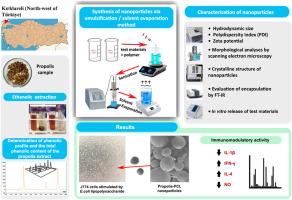聚ε-己内酯纳米颗粒包封土耳其蜂胶提取物的体外免疫调节活性
IF 4.9
3区 医学
Q1 PHARMACOLOGY & PHARMACY
Journal of Drug Delivery Science and Technology
Pub Date : 2025-09-05
DOI:10.1016/j.jddst.2025.107495
引用次数: 0
摘要
综合研究表明蜂胶具有多种生物学和药理活性,主要与其酚类物质含量有关。然而,蜂胶粘稠性强、味道刺鼻、水溶性低等缺点是阻碍其广泛应用的主要因素。本研究的目的是在聚ε-己内酯(PCL)聚合物中捕获土耳其蜂胶提取物,以消除其不良特征,并在体外研究其对几种免疫反应相关生物标志物的影响,并与其原始形式进行比较。类似的实验也对槲皮素进行了比较,槲皮素是一种具有抗炎活性的酚类化合物。采用单乳液-溶剂蒸发法制备了蜂胶- pcl(256±1.7 nm)和槲皮素- pcl(249±2.6 nm)纳米颗粒,其多分散指数分别为0.08±0.005和0.07±0.02。在中性(pH 7.4)和酸性(pH 6.8)条件下,蜂胶- pcl纳米颗粒的累积释放率分别为70%和77%。蜂胶- pcl显著增加了细胞因子IL-4和IFN-γ的产生(约2倍,p < 0.001),同时它还抑制了脂多糖诱导的巨噬细胞中一氧化氮的产生(超过3倍,p < 0.001)。综上所述,本研究数据首次证明了蜂胶- pcl纳米颗粒对免疫反应具有调节作用,可以用于开发具有高免疫调节性能的蜂胶产品。本文章由计算机程序翻译,如有差异,请以英文原文为准。

In vitro immunomodulatory activity of a Turkish propolis extract encapsulated in poly-ε-caprolactone nanoparticles
Comprehensive studies highlight various biological and pharmacological activities of propolis, which are associated mainly with its phenolic content. However, the undesirable properties of propolis, such as strong sticky behavior, pungent taste and low water solubility, are the main barriers to its widespread use. The objective of the present study was to entrap Turkish propolis extract in a poly-ε-caprolactone (PCL) polymer to eliminate its undesirable features and investigate its effects on several immune response-related biomarkers in vitro in comparison with its crude form. Similar experiments were also conducted with quercetin, which is a phenolic compound that possesses anti-inflammatory activity, for comparison. The single emulsion‒solvent evaporation method was used to fabricate propolis-PCL (256 ± 1.7 nm) and quercetin-PCL (249 ± 2.6 nm) nanoparticles, with satisfactory polydispersity index values (0.08 ± 0.005 and 0.07 ± 0.02, respectively). The in vitro release rates of the nanoparticles displayed an initial burst stage, followed by a persistent release stage extending for more than 300 h. The cumulative release rates for propolis-PCL nanoparticles at neutral (pH 7.4) and acidic (pH 6.8) conditions were 70 % and 77 %, respectively. Propolis-PCL significantly increased the production of the cytokines IL-4 and IFN-γ (approximately 2-fold, p < 0.001), while it also inhibited nitric oxide generation (by more than 3-fold, p < 0.001) in lipopolysaccharide-induced macrophages. In conclusion, the data obtained in this study demonstrate for the first time that propolis-PCL nanoparticles possess regulatory effects on the immune response and that these nanoparticles can be used to develop propolis products with high immunomodulatory properties.
求助全文
通过发布文献求助,成功后即可免费获取论文全文。
去求助
来源期刊
CiteScore
8.00
自引率
8.00%
发文量
879
审稿时长
94 days
期刊介绍:
The Journal of Drug Delivery Science and Technology is an international journal devoted to drug delivery and pharmaceutical technology. The journal covers all innovative aspects of all pharmaceutical dosage forms and the most advanced research on controlled release, bioavailability and drug absorption, nanomedicines, gene delivery, tissue engineering, etc. Hot topics, related to manufacturing processes and quality control, are also welcomed.

 求助内容:
求助内容: 应助结果提醒方式:
应助结果提醒方式:


